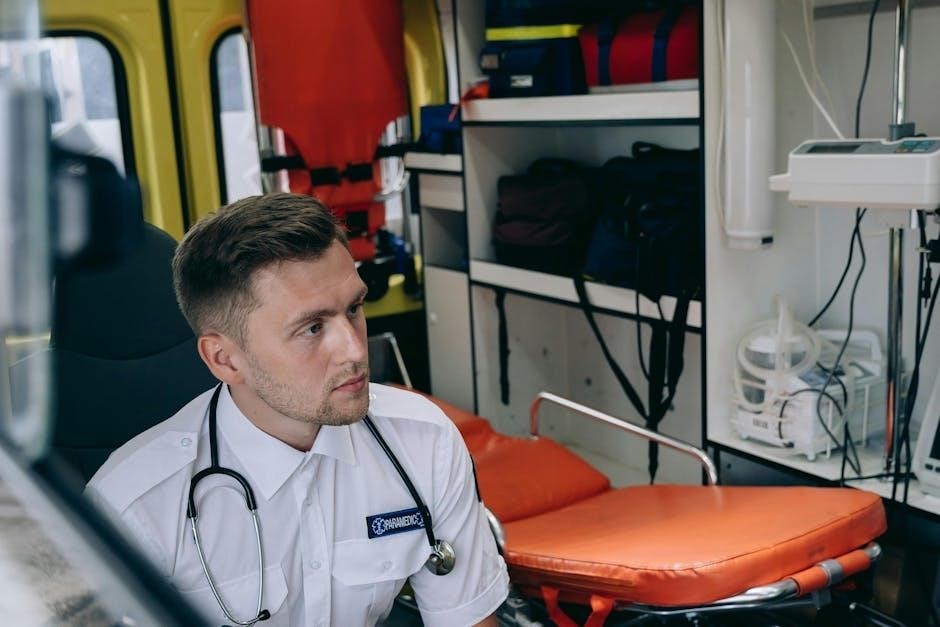The EMR certification is the entry-level credential for emergency medical services (EMS), focusing on basic life support and patient assessment. Administered by the National Registry of Emergency Medical Technicians (NREMT), it equips responders with essential skills to provide immediate care during emergencies, ensuring timely and effective interventions.
1.1. Overview of EMR Role and Responsibilities
Emergency Medical Responders (EMRs) are critical first responders trained to provide immediate care in emergency situations. Their primary responsibilities include patient assessment, basic life support, and the use of automated external defibrillators (AEDs). EMRs are skilled in airway management, bleeding control, and splinting injuries. They play a vital role in ensuring patient safety and stability until advanced medical care arrives. EMRs operate in various settings, including ambulances, fire departments, and community response teams. Their training emphasizes emergency care, patient communication, and safe movement techniques. As the first point of contact in emergencies, EMRs are essential in providing timely interventions that can significantly impact patient outcomes. Their role is foundational to the broader emergency medical services (EMS) system.
1.2. Importance of EMR Certification
EMR certification is crucial for ensuring responders possess the necessary skills and knowledge to deliver effective emergency care. It validates their ability to perform basic life support, patient assessment, and use essential medical devices. Certification serves as a benchmark, confirming that EMRs can provide reliable, timely interventions in critical situations. It also ensures a standardized level of care across emergency medical services (EMS). By obtaining certification, EMRs demonstrate their commitment to professional competence, enhancing public trust and safety. The certification process, including training and testing, prepares responders to handle diverse emergencies confidently, making it a foundational requirement for anyone entering the EMS field.

Key Topics Covered in the EMR Study Guide
The EMR study guide covers essential topics like patient assessment, basic life support (BLS), legal principles, trauma care, and managing medical emergencies, preparing responders for real-world scenarios.
2.1. Patient Assessment and Basic Life Support (BLS)
Patient assessment and BLS are critical components of EMR training. EMRs learn to evaluate patients systematically, starting with scene size-up and primary assessment, focusing on airway, breathing, and circulation (ABCs). Training includes techniques like chest compressions, use of automated external defibrillators (AEDs), and basic airway management. These skills ensure EMRs can provide immediate care, such as CPR and bleeding control, while maintaining patient safety. Proficiency in BLS is essential for preventing deterioration and improving outcomes. The study guide emphasizes hands-on practice and scenario-based learning to master these life-saving interventions effectively.
2.2. Legal and Ethical Principles in Emergency Care
Understanding legal and ethical principles is vital for EMRs to operate within established guidelines. Key topics include patient consent, confidentiality, and duty to act. EMRs must adhere to laws protecting patient rights, such as HIPAA, and understand Good Samaritan laws. Ethical dilemmas, like end-of-life decisions, require a balanced approach. The study guide emphasizes respecting patient autonomy while ensuring safety. Legal principles also cover scopes of practice, ensuring EMRs stay within their training. Proper documentation and communication are stressed to avoid liability. This section prepares responders to navigate complex situations ethically and legally, upholding professional standards in emergency care.

Effective Study Strategies for EMR Exam Preparation
Utilize practice tests and study guides to reinforce knowledge. Employ flashcards for medical terminology and key concepts. Interactive tools and consistent review enhance understanding and retention of critical skills.
3.1. Utilizing Practice Tests and Study Guides
Practice tests and study guides are essential tools for EMR exam preparation. They help familiarize candidates with the test format, including question types and content. Regularly taking practice tests allows responders to identify knowledge gaps and focus on weak areas. Study guides provide structured learning materials, covering critical topics like patient assessment, trauma care, and legal principles. Interactive tools, such as flashcards and online quizzes, enhance retention of medical terminology and procedures. By consistently reviewing and practicing, responders can build confidence and improve their ability to apply knowledge under exam conditions. These resources are key to achieving success in the EMR certification process.
3;2. Mastering Medical Terminology and Anatomy
Mastering medical terminology and anatomy is crucial for EMR certification. Understanding terms like “rales” (crackles in the lungs) and “stridor” (abnormal breathing sounds) aids in accurate patient assessments. Anatomy knowledge, such as locating fractures or internal injuries, ensures proper care. Flashcards and interactive tools can help memorize complex terms. Mnemonics and diagrams enhance retention of anatomical structures. Regular review of these concepts strengthens foundational knowledge, enabling responders to communicate effectively and apply procedures correctly. This expertise is vital for providing precise care and ensuring patient safety during emergencies. Consistent practice and review of medical terminology and anatomy are essential for success in the EMR exam and real-world scenarios.
EMR Test Format and Content
The EMR exam includes multiple-choice questions covering EMS systems, patient assessment, trauma care, and medical emergencies. It is computer-based and administered at approved testing sites.
4.1. Understanding the Structure of the EMR Exam
The EMR exam is a computer-based test divided into multiple sections, each focusing on specific skills and knowledge areas. Candidates are presented with multiple-choice questions that assess their understanding of patient assessment, trauma care, medical emergencies, and legal/ethical considerations. The exam structure includes timed sections, with questions distributed across various cognitive levels to ensure comprehensive evaluation. Understanding the exam format helps candidates develop effective test-taking strategies, such as time management and prioritizing high-weightage topics. The exam is designed to evaluate both theoretical knowledge and practical application, ensuring responders are prepared to handle real-world emergencies effectively.
4.2. Sample Questions and Answers
Sample questions and answers are essential for EMR exam preparation, providing insights into the test format and content. These questions cover key topics such as patient assessment, trauma care, and legal considerations. For example, a question might ask, “What is the primary role of an EMR at an emergency scene?” with answers like “Provide basic life support” or “Administer advanced medications.” Another example could focus on respiratory sounds: “Which sound indicates a partially obstructed airway?” with options like “Stridor” or “Wheezes.” Analyzing these questions and their correct answers helps candidates identify knowledge gaps and improve test-taking strategies. Utilizing online resources and practice tests ensures thorough preparation for the exam.

Essential Skills for Emergency Medical Responders
Essential skills include trauma care, injury management, and handling medical emergencies. EMRs must also manage environmental hazards and communicate effectively to ensure patient safety and proper care.
5.1. Trauma Care and Injury Management
Trauma care and injury management are critical skills for EMRs, focusing on assessing and stabilizing patients with injuries from accidents or violence. EMRs learn to identify and manage fractures, burns, head injuries, and internal bleeding. Techniques include immobilization, wound cleaning, and splinting to prevent further harm. Proper assessment ensures timely interventions, such as controlling bleeding or managing shock. EMRs also handle environmental hazards, ensuring scene safety. Effective communication and documentation are vital for continuity of care. Staying updated on protocols and best practices enhances patient outcomes in emergency situations. These skills are essential for providing immediate, life-saving interventions in traumatic scenarios.

5.2. Handling Medical Emergencies and Environmental Hazards
EMRs must be adept at managing medical emergencies, such as cardiac arrests, strokes, and respiratory distress, while also addressing environmental hazards like hypothermia or heatstroke. Training includes scene safety assessments to ensure responder and patient well-being. EMRs learn to stabilize patients in diverse settings, applying techniques like oxygen therapy and splinting. Environmental hazards require specific interventions, such as treating exposure-related injuries or evacuating dangerous areas. Effective communication and rapid decision-making are crucial in these high-stress situations. Understanding triage principles enables EMRs to prioritize care during multiple-casualty incidents. Mastery of these skills ensures EMRs can adapt to varying emergencies, providing critical interventions that improve patient outcomes in challenging environments.

Resources for EMR Exam Preparation
Utilize study guides, practice tests, and flashcards to prepare effectively. Online resources, including PDF downloads and interactive tools, provide comprehensive coverage of exam topics and essential skills.
6.1. Recommended Study Materials and Online Resources
Essential resources for EMR exam preparation include the Emergency Medical Responder Candidate Handbook and the official NREMT study guide. Online platforms like Quizlet and Varsity Tutors offer interactive flashcards and practice tests. Additionally, downloadable PDFs, such as the EMR Practice Test PDF, provide realistic exam simulations. The Emergency Care for Professional Responders textbook is highly recommended, along with EMR Cheat Sheets for quick reference. Utilize free resources like Varsity Tutors Learning Tools and MiningQuiz for targeted practice. These materials ensure comprehensive coverage of exam topics, helping candidates master medical terminology, patient assessment, and emergency care protocols effectively.

6.2. Flashcards and Interactive Practice Tools

Flashcards and interactive tools are invaluable for reinforcing key concepts in EMR preparation. Platforms like Quizlet offer digital flashcards covering medical terminology, patient assessment, and emergency protocols. Interactive tools, such as Varsity Tutors Learning Tools, provide personalized study plans and real-time progress tracking. MiningQuiz and similar sites offer practice tests with detailed scoring to identify areas for improvement. These resources engage learners through gamification, making complex topics more approachable. They also cover essential exam topics like BLS techniques, trauma care, and legal principles. Regular use of these tools enhances retention and confidence, ensuring candidates are well-prepared for the EMR exam.

Final Exam Preparation Tips
Thoroughly review your study guide, focus on high-weight topics, and practice time management. Utilize flashcards for last-minute retention and remain calm to ensure optimal performance during the exam.
7.1. Time Management and Test-Taking Strategies
Effective time management is critical during the EMR exam. Allocate time evenly across all questions, spending no more than 1-2 minutes per question. Prioritize high-weight topics like patient assessment and trauma care. Skim through questions to identify key details quickly. Use the process of elimination to narrow down answers, and avoid changing answers once decided. Practice with timed mock tests to build stamina and familiarity with the format. Stay calm and systematic to maintain focus throughout the exam. Reviewing practice tests helps identify weak areas, allowing for targeted preparation. By mastering these strategies, candidates can optimize their performance and confidence during the final exam.

7.2. Common Mistakes to Avoid During the Exam
During the EMR exam, common mistakes include rushing through questions, misreading stems, and failing to manage time effectively. Overconfidence can lead to skipping steps, while excessive doubt may result in unanswered questions. Candidates often misunderstand the scope of practice, confusing EMR roles with higher-level certifications. Guessing without eliminating incorrect options increases error risk. Neglecting to review the exam format and content beforehand can cause unnecessary stress. Overcomplicating straightforward questions is another pitfall. Lastly, failing to stay calm and systematic under pressure can impair decision-making. By being aware of these mistakes, candidates can adopt strategies to avoid them, ensuring a more confident and accurate performance.
